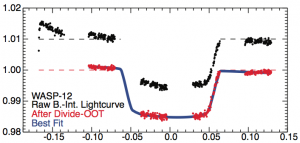Very cool result that, for some reason, only just appeared in the press. Using the Hubble Space Telescope, Avi Mandell and co-authors detected spectral signatures of water in the atmospheres of several very hot, transiting exoplanets.
The figure at left shows the transit signal for WASP-12 b, a very hot gas giant planet that is so close to its host star that the star may be ripping the planet apart.
To get a sense for how impressive these detections are, consider the following: given the temperature and radius for the host star WASP-17, which is about 1,000 lightyears away, we receive about 1 pico-Watt per square meter from the star here on Earth [ (1.38 R_sun/1000 lightyears)^2 (sigma) (6509 K)^4 ~ 1 pW/m^2].
That’s about the same amount of energy we’d receive from a 1000-Watt lightbulb suspended in space 10,000 km from the Earth [1000 W / 4 pi (10000 km)^2 ~ 1 pW/m^2].
The planet WASP-17 b has a radius roughly a tenth that of its host star, giving a transit depth [(radius of the planet)^2/(radius of the star)^2] of about 1% (as seen in the figure). For comparison, the radius of a standard lightbulb is about 3 cm and that of a fruitfly is about 2 mm.
So being able to measure a spectrum for WASP-17 b in-transit is a bit like watching a fruitfly pass in front of a lit lightbulb at a distance of 10,000 km from Earth and being able to tell what color the fly’s wings are. Very cool stuff.
Mandell’s paper is here: http://adsabs.harvard.edu/abs/2013arXiv1310.2949M.
